 |
| THE GATE OF PERSECUTION & FORTIFICATIONS
The Church of St. John, located on the southern slopes of Ayasuluk Hill is encircled by fortifications. This eliptic area, also including the inner castle, is 500 m long (N-S) and 180 m wide (E-W). The material used in the construction of the towers and the walls is mostly the re-used material from Ephesus and Artemision. |
|
| The fortifications built separately as inner and outer walls at different times have also different construction techniques. The fortifications have a total of 20 towers and 3 gates. The best - preserved and most monumental of these gates is the Gate of Persecution to the south. The other gates are to the north-east and north-west of the church. |
|
| THE GATE OF PERSECUTION
The Gate of Persecution is the gate at the beginning of the way to the church. The gate is reached from the bus park area via a rampart paved with marble. The arched entrance in the middle is flanked with two square towers. On the outside, over the arch is a frieze decorated with vegetal scrolls and over this are the front side and a fragment of the lateral side of a sarcophagus decorated with Erotes. |
|
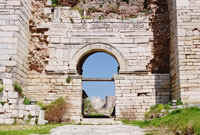 |
|
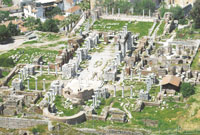 |
|
THE CHURCH OF ST. JOHN
The floor plan of the church resembles that of the Church of the Holy Apostles in Constantinople, which lies under the Fatih Mosque today. Procopius describes the Church of the Holy Apostles as follows: "Afterwards, as showing very special honor to all the Apostles altogether, he did as follows. |
|
| There was in Byzantium from ancient times a church dedicated to all the Apostles; but having by now been shaken by the passage of time, it had fallen under the suspicion that it would not continue to stand. This the Emperor Justinian pulled down entirely, and he was at pains not simply to restore it, but to make it more worthy both in size and beauty. |
|
| NARTHEX (VESTIBULE)
Narthex is the hall between the atrium and the main hall of the church. The word 'narthex' itself means 'entrance foyer or vestibule'. Like in the other major churches, there are eight doorways opening into the narthex. The northernmost one and the southernmost one let the people come in from outside. |
|
 |
|
| Three in the east open into the main hall. One of these three wide and tall doorways has been restored. To the west three other doorways open into the exonarthex (outer vestibule), which was added later. In the middle part of the narthex are four short semi - columns by the doorways. These semi columns belong to the windows on the upper level and have distinctive cross and vegetal decoration on the capitals. |
|
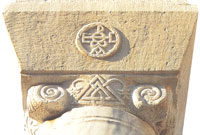 |
|
NAVE AND AISLES (NAOS)
The Church of St. John is cruciform in plan. The western arm of the cross has a nave and two aisles. The nave in the middle is wider and single storied. The side aisles are narrower and two storied. Following the excavations, the walls were elevated and all the columns of the ground floor and the columns of the north gallery were re-elected. |
|
| BEMA (BURIAL AREA) AND SYNTHRONON
Bema is located where the nave and aisles intersect with the transepts. Bema is above the ground level, just as the solea is. Under the bema is the tomb of St. John (Confessio). The floor of the bema was covered with polychrome geometric decorated panels. In the middle of the bema was the altar and there are four short columns, part of the ciborium. Ciborium had four arches supporting a small dome and accentuated the altar. |
|
| The bema is surrounded by columns and balustrades, some of which have been restored. To the east of the bema is the synthronon where the priests used to sit during the masses. The brick substructure of the synthronon has been recently restored. It is certain that the synthronon was faced with pink marble. In the middle of the synthronon was a cathedra, an armchair for the highest ranked priest to sit. |
|
 |
|
| The decorated Byzantine architrave on the columns surrounding the bema bear on the outer and inner sides, an inscription from the Old Testament. These belong to the Middle Byzantine Era (11th c.), the last phase of the church. It is generally accepted that the dome over the bema was bigger than the other domes and had windows on the drum. Such a dome, as reported by Procopius in the description of the Church of the Holy Apostles in Constantinople (Istanbul), provided light to the central part of the building. In the east part of the bema, there is an iron grid closing off the staircase going down into a narrow corridor giving way to the crypt. To the west of this opening is another hole with iron bars opening into the corridor. According to the tradition, on certain days of the year, the holy dust was given through this hole. |
|
 |
|
THE TOMB OF ST. JOHN (CRYPT)
The tomb and the burial area were unearthed by the first excavator, Greek archaeologist G. A. Soteriu, in 1920 - 22. The researcher did not include any information about the tomb, in the first publication. However, in the publication (FiE 4, 1951) prepared by the Austrian Archaeological Institute together with G. A. Soteriu, |
|
|
details were given about the crypt. According to this publication, right under the ciborium in the middle, as ancient authors mentioned, four burials were found. These tombs built with brick and stone roughly formed a cross around a center. The one in the E - W direction located in the middle is larger than the rest which are all in N - S direction. This larger tomb was purported to be the tomb of St. John, the Apostle and the Theologian (Gschwind 1965, 50 fig. 1). The tombs were all empty when excavated. |
|
| It is certain that the other tombs were added later on but it is hard to say who were buried in them. This topic has not been researched thoroughly so far, however, the author agrees that the larger tomb in the middle should be the tomb of St. John, as purported above, based on its location. Starting from the Early Christian Period it was believed that the dust taken from this tomb would heal illnesses. |
|
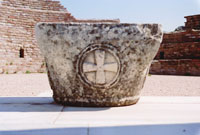 |
|
| Pilgrims usually stopped here on the way to Jerusalem and took some dust with them. Another myth related with St. John is that his tomb rose and lowered as if breathing. This can be interpreted as the populace did not believe St. John had died. These two myths are believed to result in the naming of the city as "Ayasoluk" by Turks. Perhaps the name Ayasoluk means "Holy Breath".
In the Christian tradition that emerged in the 2nd century, St. John the Theologian of Ephesus is the same person as the Apostle John and as the author of the Fourth Gospel, the Epistles and the Book of Revelation (pillinger 1996, 51; Boyokkolancl 1995a, 192). Pope Paul VI prayed here on July 26, 1967 and since 1990 in the first week of May prayers are held here with the permission granted by the Ministry of Culture. |
|
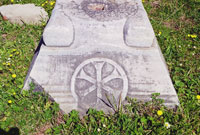 |
|
THE APSE AND THE TRANSEPTS
The apse, located to the east, is a must in every church and mostly a semicircle. In a normal sized church or basilica, the synthronon and the altar are located just before the apse. However, in a huge sized church, like the Church of St. John in Ephesus, the altar is located in the center on the bema. |
|
Therefore, the synthronon is brought near the altar, leaving the apse far back (similarities can be found in big cathedrals like Koln Dom, Germany). One may go up the synthronon steps
in order to have a view of the apse and decorated pillars of the altar. |
|
| TREASURY (SKEUOPHYLAKION)
This structure was unearthed in 1978 campaign carried out by the Museum's team and is located to the north of the north transept. It has a complex plan with its narthex and an apsidal room to the east adjoining the north transept. Its outer dimensions are 11 .85 m x 14.25 m. The outer walls are in good state of preservation. A section of wall in the north-west corner, standing to a height of 4.60 m today, proves the existence of a second story. |
|
|
The narthex and the apsidal 'room to the south were planned
and built simultaneously. Existing north wall of the north transept and the east wall of the baptistery were incorporated in the construction. The narthex (vestibule) located between the main hall and the transept measures 11 .00 m x 3.15 m on the inside. There are doors at both semicircular ends. The eastern door opens into the chapel whereas the western door opens to the baptistery. |
|
 |
|
| The door in the north wall opens into the main hall and the door in the south wall provides access to the north transept. The floor is paved with marble. The narthex originally had a barrel vault. The apsidal room to the east of the narthex (3.75 m x 3.15 m) was planned and built along with the treasury. It is covered with a timber and tile roof today. This room originally was part of the treasury complex but in the course of alterations in the 11th century it was converted to a chapel. |
|
 |
|
BAPTISTERY
The baptistery is located to the north of the naos. Between the north aisle and this large building of 734 m2 is a corridor of 3.00 m x 34.00 m. At first glance this corridor looks like a side aisle (as shown in the plan by Hormann) but it ought to be the vestibule of the baptistery. |
|
During the construction of the Justinian church this section was covered with a vault. In the late phases of the church tombs were placed here. In the Turkish period the vestibule was used for pressing oil from olives. Relevant mill stones and drainage channels can still be seen. In this vestibule, placed in the south wall of the baptistery is a pretty Byzantine fountain, built of marble blocks. It was uncovered in 1930. The triangular pediment and supporting pillars of this rectangular fountain were procured from a Roman structure
in Ephesus. The baptistery is complex consisting of an octagonal central part surrounded by a corridor and corner rooms and flanked with apsidal halls to the east and the west. Having visited the treasury, one enters the eastern apsidal hall through the western doorway of the treasury's narthex. |
|
| ATRIUM (COURTYARD)
The atrium (courtyard) to the west of the church measures 34.70 m x 47.00 m. Unearthed in 1960 and 1975 by the Ephesus Museum's team, the atrium has a plan different than its contemporaries. It consists of three sections: the central yard open to the sky, the porticoes, and the walkway for strolling. It rests on a substructure, which was built to make room for the atrium. |
|
 |
|
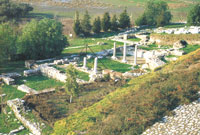 |
|
MONASTERY CHURCH
On the Slope to the West of the Atrium
In 1981, the beginning of a stone paved road was discovered between west gate of the fortifications and the north gate of Isa Bey Mosque. As the work progressed it was understood that this Ottoman road was built over some Byzantine walls and rooms. |
|
| In 1985 the work on the road was stopped and work on the rooms started. Two adjoining rooms to the north were excavated and the floor paved with big baked clay plates was reached, and a corridor to the west of these rooms, and a three-aisled basilica and other rooms to the south were unearthed. The only find from the excavations to help dating the structure is a coin from the reign of Justinian I (527 - 565), recovered during the cleaning of the nave floor. It shows that the church, and the monastery, might have been built before the reign of Justinian. |
|
|
 |
|
|
|